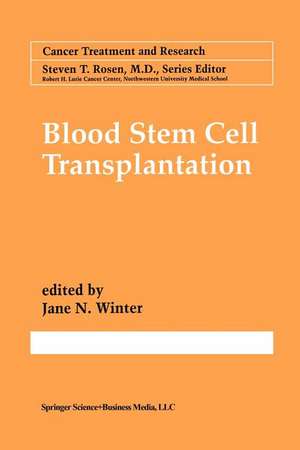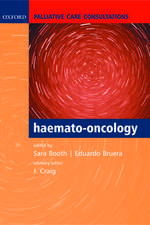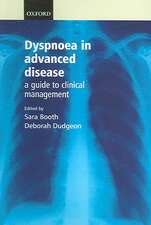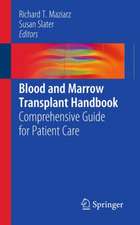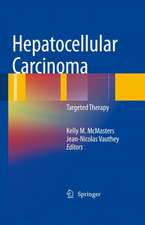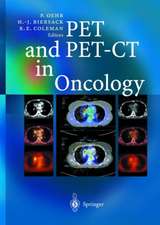Blood Stem Cell Transplantation: Cancer Treatment and Research, cartea 77
Editat de Jane N. Winteren Limba Engleză Paperback – 8 oct 2012
Possible applications of stem cell transplantation continue to grow with the identification of alternative sources of stem cells and the potential to engineer and/orexpand the graft. Although the use of unrelated and mismatched donors continues to increase, the possibilities associated with umbilical cord blood transplantation are legion, especially if stem cells can be expanded ex vivo to provide grafts for full-sized adults. Using techniques in which contaminating malignant cells may be eliminated from autografts through positive selection, autologous transplantation may prove highly effective, especially when coupled with post-transplant immunotherapy. Some of these same methodologies have helped facilitate the use of autologous grafts for transplantation in patients with chronic myelogenous leukemia without allogeneic donors.
Advances in the supportive care of transplant patients, including the pretransplant identification of those at risk from pulmonary complications and the use of cytokines to speed engraftment, have reduced morbidity and mortality to such a degree that it is appropriate to consider high-dose therapy and stem cell reconstitution in patients with nonmalignant diseases. The impressive advances that have occurred in transplantation for thalassemia are described by pioneers in their area of investigation. The burgeoning field of transplantation for autoimmune disorders, including its immunobiologic basis and soon-to- be-realized clinical potential, is also summarized. Continued progress in the use of high-dose therapy with stem cell rescue for the treatment of pediatric tumors, which derives in part from improved supportive care, is detailed.
The sobering voice of the health care economists underscores the necessary limitations to our seemingly unbridled imagination. Cost- consciousness and financial know-how will need to be reflected in future study designs. Given the seemingly endless applications of our technology, strategies to insure its cost-effectiveness will be necessary. Continued financial support for laboratory investigation and for the clinical experiments they generate will be required if we are to go forward. Blood Stem Cell Transplantation lays the foundation for many of these future advances; it is incumbent upon us all to insure its realization.
| Toate formatele și edițiile | Preț | Express |
|---|---|---|
| Paperback (1) | 2111.37 lei 6-8 săpt. | |
| Springer Us – 8 oct 2012 | 2111.37 lei 6-8 săpt. | |
| Hardback (1) | 3190.08 lei 6-8 săpt. | |
| Springer Us – 31 mar 1997 | 3190.08 lei 6-8 săpt. |
Din seria Cancer Treatment and Research
- 5%
 Preț: 1103.03 lei
Preț: 1103.03 lei - 5%
 Preț: 726.32 lei
Preț: 726.32 lei - 5%
 Preț: 787.58 lei
Preț: 787.58 lei - 5%
 Preț: 1037.93 lei
Preț: 1037.93 lei - 5%
 Preț: 1032.64 lei
Preț: 1032.64 lei - 5%
 Preț: 1041.77 lei
Preț: 1041.77 lei - 5%
 Preț: 917.42 lei
Preț: 917.42 lei - 5%
 Preț: 719.02 lei
Preț: 719.02 lei - 5%
 Preț: 920.18 lei
Preț: 920.18 lei - 5%
 Preț: 1040.88 lei
Preț: 1040.88 lei - 5%
 Preț: 721.19 lei
Preț: 721.19 lei - 15%
 Preț: 700.10 lei
Preț: 700.10 lei - 5%
 Preț: 370.38 lei
Preț: 370.38 lei - 5%
 Preț: 2116.84 lei
Preț: 2116.84 lei - 5%
 Preț: 1414.08 lei
Preț: 1414.08 lei - 5%
 Preț: 1424.16 lei
Preț: 1424.16 lei - 5%
 Preț: 1106.69 lei
Preț: 1106.69 lei - 5%
 Preț: 1297.62 lei
Preț: 1297.62 lei - 5%
 Preț: 1103.22 lei
Preț: 1103.22 lei - 5%
 Preț: 1094.44 lei
Preț: 1094.44 lei - 5%
 Preț: 1096.45 lei
Preț: 1096.45 lei - 5%
 Preț: 1413.56 lei
Preț: 1413.56 lei - 5%
 Preț: 720.10 lei
Preț: 720.10 lei - 5%
 Preț: 706.77 lei
Preț: 706.77 lei - 5%
 Preț: 731.07 lei
Preț: 731.07 lei - 5%
 Preț: 1414.80 lei
Preț: 1414.80 lei - 5%
 Preț: 1108.72 lei
Preț: 1108.72 lei - 5%
 Preț: 1098.12 lei
Preț: 1098.12 lei - 5%
 Preț: 1092.22 lei
Preț: 1092.22 lei - 5%
 Preț: 1099.56 lei
Preț: 1099.56 lei - 5%
 Preț: 1106.33 lei
Preț: 1106.33 lei - 5%
 Preț: 1096.81 lei
Preț: 1096.81 lei
Preț: 2111.37 lei
Preț vechi: 2222.49 lei
-5% Nou
Puncte Express: 3167
Preț estimativ în valută:
404.03€ • 417.44$ • 336.10£
404.03€ • 417.44$ • 336.10£
Carte tipărită la comandă
Livrare economică 19 martie-02 aprilie
Preluare comenzi: 021 569.72.76
Specificații
ISBN-13: 9781461379164
ISBN-10: 1461379164
Pagini: 436
Ilustrații: XV, 416 p.
Dimensiuni: 155 x 235 x 23 mm
Greutate: 0.61 kg
Ediția:Softcover reprint of the original 1st ed. 1997
Editura: Springer Us
Colecția Springer
Seria Cancer Treatment and Research
Locul publicării:New York, NY, United States
ISBN-10: 1461379164
Pagini: 436
Ilustrații: XV, 416 p.
Dimensiuni: 155 x 235 x 23 mm
Greutate: 0.61 kg
Ediția:Softcover reprint of the original 1st ed. 1997
Editura: Springer Us
Colecția Springer
Seria Cancer Treatment and Research
Locul publicării:New York, NY, United States
Public țintă
ResearchCuprins
I. Developments in Immuno-, Molecular, and Cell Biology: Implications for Clinical Stem Cell Transplantation.- 1. Gene therapy of solid tumors and hematopoietic neoplasms.- 2. Post-bone marrow transplant use of immunotherapy.- 3. Graft-versus-leukemia effect of allogeneic bone marrow transplantation and donor mononuclear cell infusions.- 4. Graft-versus-host disease: implications from basic immunology for prophylaxis and treatment.- 5. The detection of minimal residual disease: implications for bone marrow transplantation.- 6. The use of radiolabeled antibodies in bone marrow transplantation for hematologic malignancies.- II. Sources of Hematopoietic Stem Cells and Their Ex Vivo Expansion.- 7. Peripheral blood stem cell harvesting and CD34-positive cell selection.- 8. Ex vivo expansion of hematopoietic stem and progenitor cells for transplantation.- 9. Allogeneic umbilical cord blood transplantation.- 10. The use of unrelated donors for bone marrow transplantation.- III. Reducing the Toxicity Associated with Hematopoietic Stem Cell Transplantation.- 11. Supportive care in bone marrow transplantation: pulmonary complications.- 12. Recombinant cytokines and hematopoietic growth factors in allogeneic and autologous bone marrow transplantation.- IV. Clinical Applications: Continued Progress and New Frontiers.- 13. Bone marrow transplantation in thalassemia.- 14. Immune ablation and hematopoietic stem cell rescue for severe autoimmune diseases (SADS).- 15. Autologous bone marrow transplantation in pediatric solid tumors.- 16. Autologous stem cell transplantation for the treatment of chronic myelogenous leukemia.- V. A New Challenge for the Field of Stem Cell Transplantation: Financial Constraints.- 17. Health care economics and bone marrow transplantation.
